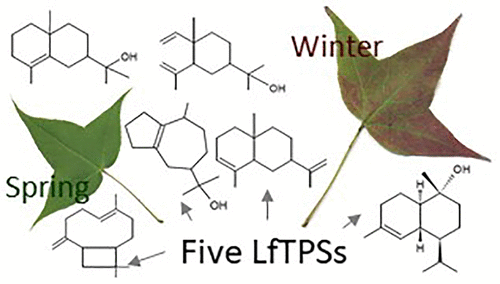当前位置:
X-MOL 学术
›
J. Nat. Prod.
›
论文详情
Our official English website, www.x-mol.net, welcomes your
feedback! (Note: you will need to create a separate account there.)
Identification, Functional Characterization, and Seasonal Expression Patterns of Five Sesquiterpene Synthases in Liquidambar formosana
Journal of Natural Products ( IF 3.3 ) Pub Date : 2018-05-10 00:00:00 , DOI: 10.1021/acs.jnatprod.7b00773 Ling Chuang,Chi-Hsiang Wen,Yi-Ru Lee,Yan-Liang Lin,Li-Ren Hsu,Sheng-Yang Wang,Fang-Hua Chu
Journal of Natural Products ( IF 3.3 ) Pub Date : 2018-05-10 00:00:00 , DOI: 10.1021/acs.jnatprod.7b00773 Ling Chuang,Chi-Hsiang Wen,Yi-Ru Lee,Yan-Liang Lin,Li-Ren Hsu,Sheng-Yang Wang,Fang-Hua Chu

|
Terpenoids are a large group of important secondary metabolites that are involved in a variety of physiological mechanisms, and many are used commercially in the cosmetics and pharmaceutical industries. During the past decade, the topic of seasonal variation in terpenoid biosynthesis has garnered increasing attention. Formosan sweet gum (Liquidambar formosana Hance) is a deciduous tree species. The expression of terpene synthase and accumulation of terpenoids in leaves may vary in different seasons. Here, four sesquiterpene synthases (i.e., LfTPS01, LfTPS02, LfTPS03, and LfTPS04) and a bifunctional mono/sesquiterpene synthase (LfTPS05) were identified from Formosan sweet gum. The gene expression of LfTPS01, LfTPS02, and LfTPS03 showed seasonal diversification, and, in addition, expression of LfTPS04 and LfTPS05 was induced by methyl jasmonate treatment. The major products LfTPS01, LfTPS02, LfTPS04, and LfTPS05 are hedycaryol, α-selinene, trans-β-caryophyllene, α-copaene/δ-cadinene, and nerolidol/linalool, respectively. The data indicated that the sesquiterpenoid content in the essential oil of Formosan sweet gum leaves shows seasonal differences that were correlated to the sesquiterpene synthase gene expression.
更新日期:2018-05-10











































 京公网安备 11010802027423号
京公网安备 11010802027423号